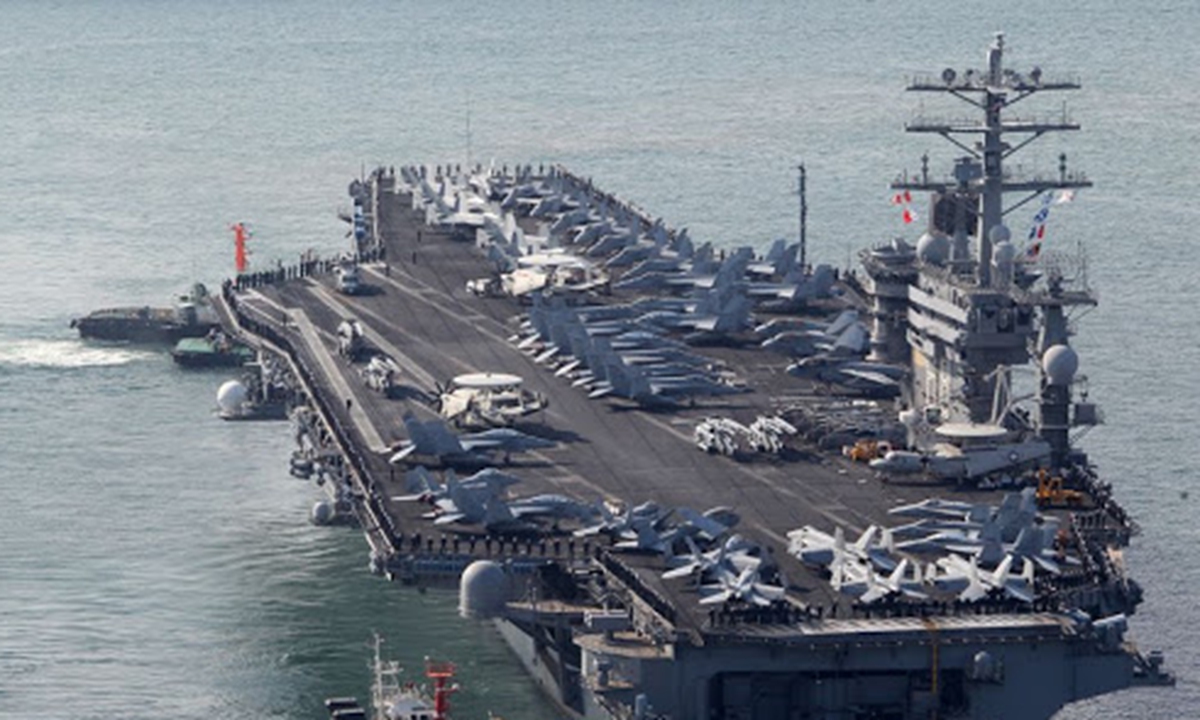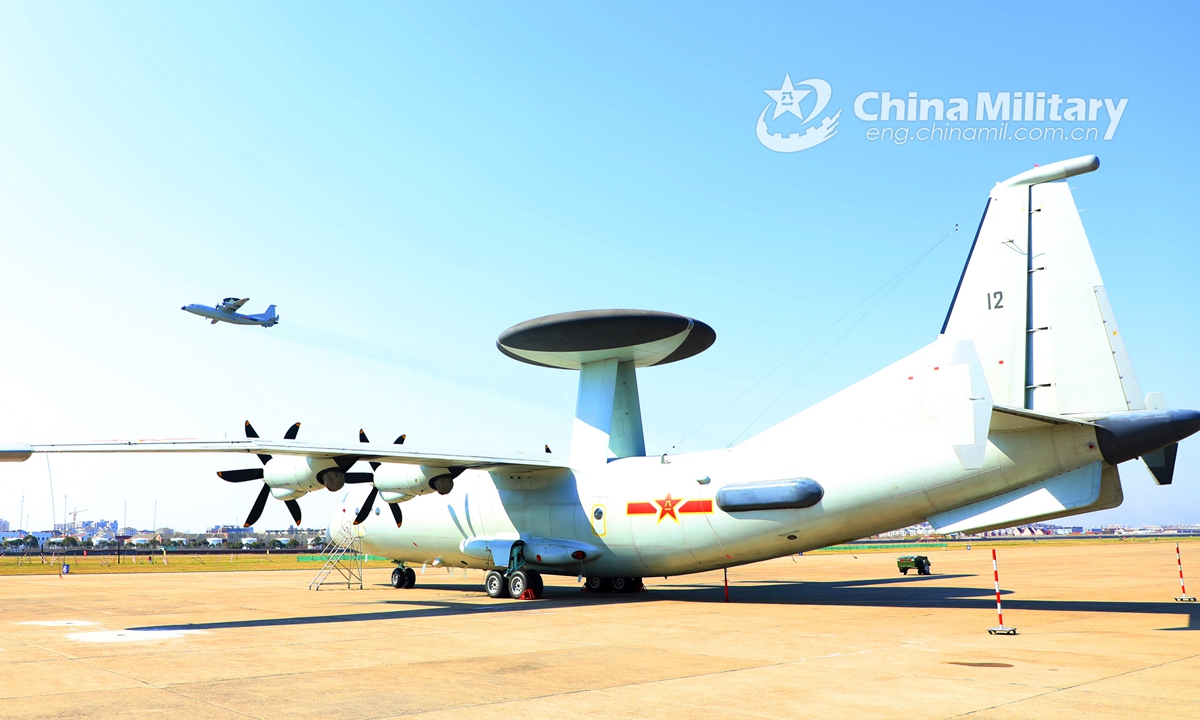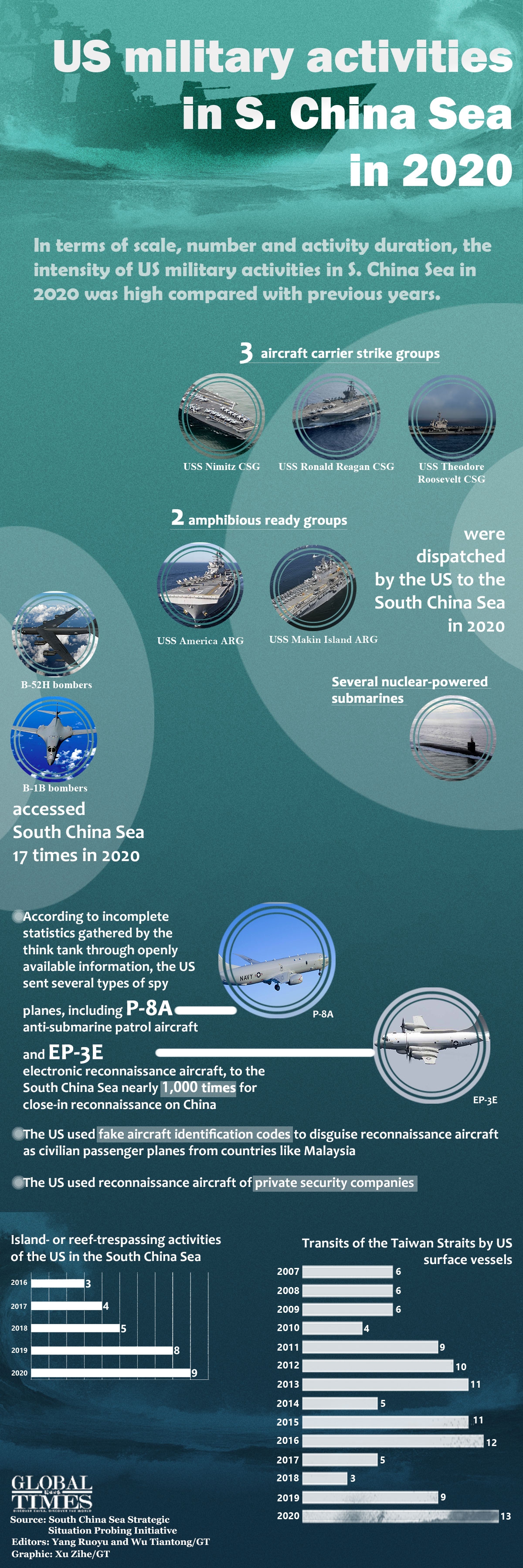
Photo: Xinhua
In unprecedented moves that aimed to deter China, the US military repeatedly deployed strategic weapon platforms, including aircraft carrier strike groups, to the South China Sea in 2020. It is likely that it will continue to rally regional allies and partners to interfere in regional affairs and enhance its frontier military presence, as well as the intensity of its activity in the region in an effort to achieve maritime containment of China, a recent report by a think tank focusing on the South China Sea shows.
This is the third consecutive year the Beijing-based South China Sea Strategic Situation Probing Initiative (SCSPI) has published reports on US military activities in the South China Sea, as the US military has been increasing operation frequency, intensity and focus in the region in recent years.
According to the SCSPI, the US dispatched aircraft carrier strike groups, amphibious ready groups, nuclear-powered submarines, and B-52H and B-1B bombers to the South China Sea in 2020.
In terms of scale, number and activity duration, the high intensity of US military activities in 2020 is extraordinary compared with previous recent years. Due to the impact of the COVID-19 pandemic, it increased intensity and frequency of aerial and underwater activities to make up for the lack of surface force and maintain and strengthen its military presence in the region, Hu Bo, director of SCSPI, told the Global Times prior to the release of the report.
In July 2020, the US conducted dual aircraft carrier group exercises twice within half a month, which is widely seen by analysts as a rare move.
It showed some new characteristics of US carrier group deployment in the South China Sea and surrounding waters, Hu pointed out.
"First, it was very combat-oriented. For example, the USS Ronald Reagan carrier repeatedly moved into and out from the South China Sea fast, and coordinated flank attacks with other carrier strike groups. Second, US carriers operated in a wider area. For instance, the USS Theodore Roosevelt carrier strike group practiced operational application of expeditionary forces near the Zhongsha Islands for the first time. Third, the dual carrier exercises were also pointed ones, as they were conducted at a sensitive time coinciding with exercises by the People's Liberation Army (PLA) near the Xisha Islands and the Han Kuang exercises by the military on the island of Taiwan," Hu explained.
According to incomplete statistics gathered by the think tank through openly available information, the US sent several types of spy planes, including P-8A anti-submarine patrol aircraft and EP-3E electronic reconnaissance aircraft, to the South China Sea close to a thousand times for close-in reconnaissance on China.
The think tank pointed out that the US significantly boosted the frequency and intensity of its reconnaissance activities whenever the surface vessels of the US Navy were conducting major operations like the so-called Freedom of Navigation operations near the Xisha and Nansha islands, or China conducted major military activities, meaning the US focuses heavily on the cooperation of maritime and aerial forces, Hu said, noting that the main subjects of US aerial reconnaissance include sensitive areas along the coast of South China, particularly key military facilities.

A KJ-500 airborne early warning (AEW) aircraft attached to a naval aviation division under the PLA Eastern Theater Command gets ready for a flight training exercise on subjects including reconnaissance and early warning, anti-submarine tactics, etc. on February 20, 2021.Photo:China Military
The US used some new approaches in reconnaissance in 2020, including using fake aircraft identification codes to disguise reconnaissance aircraft as civilian passenger planes from countries like Malaysia, which disrupted aviation order and flight safety, and brought major risks to civilian aircraft. The US also used reconnaissance aircraft of private defense companies.
Dubbing these moves as "gray operations," Hu said the US increased the risk of misjudgment between the Chinese and US militaries.
On Wednesday, the US Defense Department released its Annual Freedom of Navigation Report for Fiscal Year 2020, claiming the US military conducted so-called freedom of navigation in the South China Sea and East China Sea, without publishing the number of operations. Previous SCSPI data show the US conducted such operations in the South China Sea five times in 2018 and eight times in 2019.
Hu revealed that in 2020, the US military conducted a high amount of island- or reef-trespassing activities in the South China Sea, and transits of the Taiwan Straits, in the name of "freedom of navigation" and "overflight," and they marked the highest numbers in recent years in terms of both frequency and intensity.
The US conducted nine island- or reef-trespassing activities in the South China Sea, namely five near the Xisha Islands and four near the Nansha Islands, Hu detailed.
US surface vessels also conducted 13 transits of the Taiwan Straits in 2020, Hu said, noting that the moves encouraged secessionist forces on the island of Taiwan and sent very dangerous signals to "Taiwan independence" forces, posing a very big threat to peace and stability in the region.
COVID-19 ravaged the globe in 2020, and several US warships were struck by the coronavirus.
While this resulted in a significant decrease in the scale and number of US exercises in the South China Sea, it did not stop it from rallying its allies for gunboat diplomacy. It conducted bilateral and multilateral exercises with countries like Japan and Australia in the South China Sea several times in an effort to continue to strengthen regional presence, push forward military cooperation with regional allies and expand military deterrence on China, Hu said.
With Joe Biden becoming the new US president, Hu predicted that the Biden administration will not change the course of strategic competition against China, either politically or militarily. This means the trend of military tensions between the two countries in regions around China, including the South China Sea, will likely remain, as US warships and warplanes will continue to frequently enter the region for different types of activities, he said.
The US will also further rally its regional allies and partners to interfere with South China Sea affairs, because, while the US still maintains a significant military advantage in the world, this advantage is gradually being lost in the western Pacific, as China's countermeasures are being greatly enhanced, Hu said.
Military provocations and deterrence from the US will undoubtably further escalate regional tensions, and under the slogan of great power competition, the US military will continue to increase the intensity and frequency of operations in the South China Sea, Hu predicted. "The only things that could change are individual tactics and approaches."

Infographic: GT






